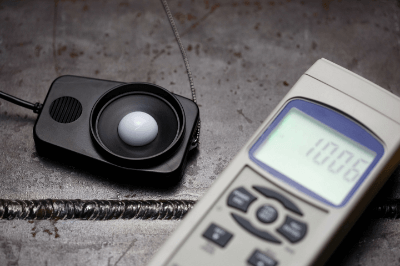What Is a Luminance Meter?

A luminance meter is a device used to measure luminance, the unit of brightness as perceived by the human eye.
It measures the luminance of a light source or an object reflecting light from a source, primarily used in the development and inspection of lighting fixtures and displays. The device employs a photodiode, which transmits an electrical signal in response to light intensity, for this purpose.
Luminance meters can measure luminance by color. They achieve this by spectrally dividing light into the three primary colors and measuring their luminance separately.
Uses of Luminance Meters
Luminance meters are used to measure the output of light sources, in the development and inspection of displays, and in devices that employ luminance for non-contact measurements. They enable quantitative evaluation of lighting brightness, setting a standard for consistent measurement.
When selecting a luminance meter, consider factors such as measurement accuracy, color compatibility, and the focusing ability of the attached lens.
Principle of Luminance Meters
1. Light Detection
A luminance meter comprises a lens, imaging surface, aperture, correction filter, and detector. During measurement, light is projected onto the imaging surface inside the meter through the lens. The aperture isolates light from the measurement area, which is then corrected by the filter to match human visual perception. The luminance is measured using a detector equipped with a photodiode. A diffraction grating, placed between the aperture and the correction filter, divides the light into three primary colors for separate measurements by the detector.
2. Focus Adjustment
The meter uses an objective lens for measurement. Proper focus is crucial to measure the light source accurately. It is important to maintain a consistent distance between the light source and the luminance meter and to have a focus adjuster to avoid focus shifts.
Other Information on Luminance Meters
1. Scale Calibration
To calibrate the luminance meter, use a diffuse reflector or a diffuse transmissive plate with a light distribution that is even and obeys the cosine law. A luminous intensity standard bulb with a distribution temperature of 2856 K is generally used as the light source.
If the illuminance on the diffuse surface is E, the reflectance of the diffuse surface is ρ, and the light distribution of the reflection obeys the cosine law, the luminance L (cd/m2) of the reflective surface can be expressed by the following formula.
L = ρE / π
No matter which direction the luminance meter is placed, it can be calibrated as long as the measurement viewing angle can be contained within the reflective surface. The output of the luminance meter can be calibrated from L calculated by E and ρ, which can be calculated from the luminous intensity I (cd) of a standard bulb and the distance S (m) between the bulb and the reflective surface.
Since the measurement of reflectance is not easy, it is reasonable to assume that the luminance calculated with a well-created reflective surface is accurate by approximately ±3-5%.
2. Check Before Measurement
Before measuring luminance, ensure the meter is properly calibrated and the viewing angle is suitable. Confirm that the power supply for the lighting is regulated to the specified voltage and the fixtures are correctly installed. Also, consider the relationship between the field of view, the meter’s position, and the measurement point.
3. Precautions During Measurement
Before measurement, allow light bulbs to warm up for at least 5 minutes and discharge lamps for 30 minutes. Measure the power supply voltage close to the light source. The luminance system requires a 5-minute exposure for stabilization. With sensitivity-switching luminance meters, avoid readings in the 0 to 1/4 scale range, if possible.